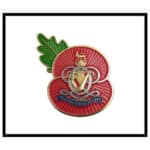The rank was formerly used in British cavalry units, introduced in 1813 to replace the quartermaster as the senior Non-Commissioned Officer of a troop, and was roughly equivalent to a Colour Sergeant in the infantry.
As the squadron replaced the troop as the main tactical and administrative division of the regiment, the Squadron Sergeant Major superseded the Troop Sergeant Major.
It was revived in 1938 as an appointment of the short-lived rank of warrant officer class III (WOIII). The new Troop Sergeant Major, and his infantry counterpart, the Platoon Sergeant Major, were part of an experiment in giving experienced NCOs command of units (troops and platoons) formerly reserved for commissioned officers. The experiment was not considered a success, and no promotions were made to the rank after 1940; most existing WOIIIs were commissioned as Lieutenants.
The old appointment is why Staff Sergeants within the Queen’s Royal Hussars are still referred to and addressed as “Sergeant Major”.
A Sergeant Major in the Regiment can command a Tank Troop, in the same way as the old WOIII Troop Sergeant Majors or hold the role of Squadron Quartermaster Sergeant (SQMS).

The man on the left, receiving a drink is identified in Murray’s regimental history as Troop Sergeant-Major Clarke. The other man is Sergeant O’Meara. Clarke’s blue cap is clearly shown as having a gold lace band in the shamrock pattern and a small gold braid design on top. Both men are in undress, with gold braided blue jackets and blue trousers that have a yellow stripe (which cannot be seen in early photos such as this).
Clarke’s arm badges are of interest because they show four gold chevrons with an embroidered harp above and an embroidered Royal crest above the harp. The Circular Memorandum of 22nd May 1850 laid down rules for NCOs’ arm badges. Regimental and Troop Sergeant-Majors of Hussar regiments were to have four gold chevrons and a regimental badge displayed on their pelisse, dress jacket and undress jacket. Sergeants were to have three chevrons and the regimental arm badge on the pelisse and dress jacket only.
The badges for each Hussar regiment were specified. The 7th, 11th and 15th were to have a crown only. The 10th was to have a crown and Prince of Wales’s Plume, and the 8th to have a crown and harp. It seems that the 8th did not follow the memorandum very closely as they had the Royal crest (lion on crown)instead of the crown. Sergeant O’Meara has the 3 chevrons and no other badges since he is wearing undress uniform.



